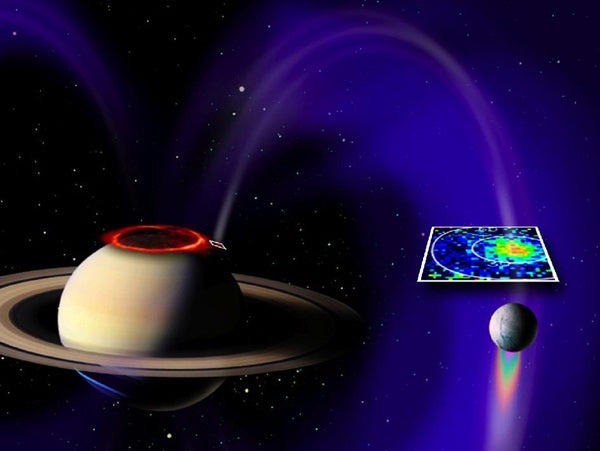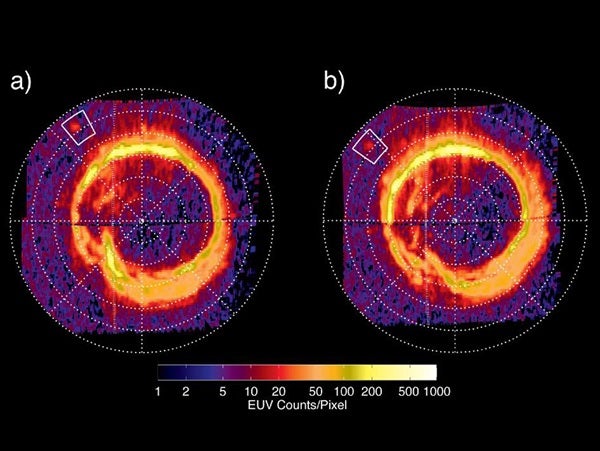Scientists previously theorized an electrical circuit should exist at Saturn. After analyzing data that Cassini collected in 2008, scientists saw a glowing patch of ultraviolet light emissions near Saturn’s north pole that marked the presence of a circuit, even though the moon Enceladus is 150,000 miles (240,000 kilometers) away from the planet.
The patch occurs at the end of a magnetic field line connecting Saturn and Enceladus. The area, known as an auroral footprint, is the spot where energetic electrons dive into the planet’s atmosphere, following magnetic field lines that arc between the planet’s north and south polar regions.
“The footprint discovery at Saturn is one of the most important fields and particle revelations from Cassini and ultimately may help us understand Saturn’s strange magnetic field,” said Marcia Burton from NASA’s Jet Propulsion Laboratory in Pasadena, California. “It gives us the first visual connection between Saturn and one of its moons.”
The auroral footprint measures approximately 750 miles (1,200 km) by less than 250 miles (400 km), covering an area comparable to California or Sweden. At its brightest, the footprint shone with an ultraviolet light intensity far less than Saturn’s polar auroral rings, but comparable to the faintest aurora visible on Earth without a telescope in the visible light spectrum. Scientists have not found a matching footprint at the southern end of the magnetic field line.
Jupiter’s active moon Io creates glowing footprints near Jupiter’s north and south poles, so scientists suspected there was an analogous electrical connection between Saturn and Enceladus. It is the only known active moon in the Saturn system with jets spraying water vapor and organic particles into space. For years, scientists used space telescopes to search Saturn’s poles for footprints, but none were found.
In 2008, Cassini detected a beam of energetic protons near Enceladus aligned with the magnetic field and field-aligned electron beams. A team of scientists analyzed the data and concluded the electron beams had sufficient energy flux to generate a detectable level of auroral emission at Saturn. A few weeks later, Cassini captured images of an auroral footprint in Saturn’s northern hemisphere. In 2009, a group of Cassini scientists led by Donald Gurnett from the University of Iowa in Iowa City detected more complementary signals near Enceladus consistent with currents that travel from the moon to the top of Saturn’s atmosphere, including a hiss-like sound from the magnetic connection.
The water cloud above the Enceladus jets produces a massive, ionized “plasma” cloud through its interactions with the magnetic bubble around Saturn. This cloud disturbs the magnetic field lines. The footprint appears to flicker in these new data, so the rate at which Enceladus is spewing particles may vary.
“The new data are adding fuel to the fire of some long-standing debates about this active little moon,” said Abigail Rymer fro the Johns Hopkins University Applied Physics Laboratory in Laurel, Maryland. “Scientists have been wondering whether the venting rate is variable, and these new data suggest that it is.”











